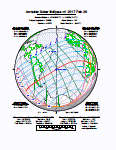![]()
| CAUTION! OBSERVING A SUN ECLIPSE IS DANGEROUS AND MAY CAUSE IRREVERSIBLE EYE DAMAGE, UP TO BLINDNESS, ANNULAR AND PARTIAL ECLIPSES INCLUDED! Observing a Sun eclipse necessitates DEDICATED SAFE TECHNIQUES! |
That first solar eclipse in 2017 is a annular eclipse occurring on February 26th, 2017. A annular eclipse is occurring when the apparent diameter of the Moon is smaller than the one of the Sun, due to the general geometry of the eclipse. A ring of Sun is still visible, surrounding the dark disk of the Moon, as it doesn't provide the observers with the more classical view of the Sun totally hidden and of the corona streaming away. for more about the solar eclipses, theoretically, see our tutorial 'Sun Eclipses'. Due to the eclipse geometry with the Moon only 4.7 days before perigee, the ring of Sun still seen will be small. The annular solar eclipse of February 26th, 2017 is occurring from the southeastern Pacific ocean to the center of southern Africa. Apart from Africa the southernmost South America is seeing the centrality with the eclipse passing in southern Chile and southern Argentina. The eclipse will then make landfall in Angola and cross the country West-East into southernmost Democratic Republic of Congo and northernmost Zambia, a area where the eclipse will be ending. Eclipse's path width is at 19.1 miles (30.6 kilometers). As the greatest eclipse occurs over the Atlantic ocean, the Sun will be lying then at a 63 degree of altitude and the eclipse lasting 44 seconds only. Like usual, a partial solar eclipse is seen either side of the line of centrality, from southern Chili, Brazil and southern West Africa down to Antarctica. The closer the central line, the more indented the Sun like southern Chili and Argentina or southern Africa (the eastern area of it excepted). The background of the total eclipse is Aquarius, the Water Bearer as the eclipse could reveal Mercury
 | A illustration of how a partial eclipse looks like either side of a total or annular; numbers match the one found on a eclipse's chart |
Eclipse's main data are the following (data as of November 2016). The Moon's apparent diameter will be of 31' 35.6", compared to the Sun's 32' 18.0". Greatest eclipse
occurs in the Atlantic ocean at 14:53:24.3 UT, the duration 00m44.0s and the Sun 62.6 degree above the horizon. for more about how to observe a solar eclipse, see our tutorial 'Observing a Sun Eclipse':
- greatest eclipse: 14:53:24.3 UT
- eclipse magnitude (fraction of the Sun's diameter obscured by the Moon at greatest eclipse): 0.9922
- U1 to U4 (moments of first-last external-internal tangency of the umbra with Earth's limb; practically these are the moments of the eclipse for the places where the eclipse is total); in UT: U1 at 13:15:18.0, U2 at 13:16:54.1, U3 at 16:30:07.4, U4 at 16:31:37.5
- P1 to P4 (moments of first-last external-internal tangency of the penumbra with Earth's limb; practically these are the moments of the eclipse for the places where the eclipse is partial), in UT: P1 at 12:10:47.6, P4 at 17:36:01.5 (no P2 nor P3 for that eclipse)
 | see a .PDF map for the annular solar eclipse of February 26th, 2017. map courtesy Fred Espenak |
. for more about this eclipse and for more about solar and lunar eclipses generally, you may see at the Internet, with Fred Espenak a reference in the domain
Website Manager: G. Guichard, site 'Amateur Astronomy,' http://stars5.6te.net. Page Editor: G. Guichard. last edited: 1/1/2017. contact us at geguicha@outlook.com